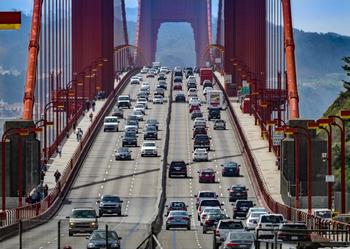
SACRAMENTO, California, September 1, 2016 (ENS) – California has unallocated proceeds from its greenhouse gas emission cap-and-trade program, and state officials have just decided how it will be spent.
Governor Jerry Brown, State Senate President pro Tempore Kevin de León and Assembly Speaker Anthony Rendon Wednesday announced an agreement on an expenditure plan that will reduce greenhouse gas emissions through programs that support clean transportation, benefit disadvantaged communities, reduce short-lived climate pollutants and protect natural ecosystems.

Under current law, 60 percent of annual auction proceeds are allocated on an ongoing basis to public transit, affordable housing, sustainable communities and high-speed rail.
The expenditure agreement invests $900 million of the remaining unallocated funds for fiscal year 2016-17, and reserves approximately $462 million for appropriation in future years.
“California’s combatting climate change on all fronts and this plan gets us the most bang for the buck,” said Governor Brown. “It directs hundreds of millions where it’s needed most – to help disadvantaged communities, curb dangerous super pollutants and cut petroleum use – while saving some for the future.”
“This agreement is the latest example of how the legislature has been both progressive and prudent this session,” said Assembly Speaker Rendon. “With this agreement, we take an aggressive approach to investing cap-and-trade funds that provides tangible results for cleaner air and helps lower income Californians benefit from emission reduction programs. At the same time, we are also maintaining a responsible reserve to provide for the future.”
“Communities across our state are already experiencing the harmful effects of climate change and air pollution and we have met this challenge with the urgency it deserves,” said Senate President pro Tempore De León.
“Whether it’s the lingering effects of a historic drought on drinking water and our agricultural sector; ferocious wildfires that have left devastation in their wake; extreme heat and heightened ozone levels that are sending children and other vulnerable groups to the emergency room,” said De León, “there is no shortage in our need for funding to make our communities healthier and more resilient.
“That’s why it’s so imperative that we put the Greenhouse Gas Reduction Fund to work immediately. I’m pleased that we’ve reached a deal to bring relief and access to clean energy to the communities that need it most,” the state Senate leader said, “and I look forward to getting this funding out the door as soon as possible so it can begin to make a difference.”
This agreement aligns with the state’s climate strategies to reduce emissions, petroleum consumption and short-lived climate pollutants, while bolstering renewable energy and energy efficiency programs.
It also targets investment in disadvantaged communities disproportionately impacted by dirty air and carbon pollution and transportation-related programs, as transportation represents the largest source of greenhouse gas emissions.
In addition, given the uncertainty associated with recent auctions of carbon credits, the agreement prudently reserves one-third of the total amount for future allocation.
The agreement includes the following appropriations:
–$368 million to the Air Resources Board, including:
–$133 million to the Clean Vehicle Rebate Program.
–$80 million to the Enhanced Fleet Modernization Program, Plus-Up Pilot Project. Up to $20 million of this may be used for other light-duty equity pilot projects.
–$150 million for heavy-duty vehicles and off-road equipment investments.
–$5 million for black carbon wood smoke programs.
–$140 million to the Office of Planning and Research for the Strategic Growth Council to provide transformative climate communities grants.
–$135 million to the Transportation Agency for the Transit and Intercity Rail Program.
–$80 million to the Natural Resources Agency for the Urban Greening program.
–$65 million to the Department of Food and Agriculture, including:
–$50 million for the early and extra methane emissions reductions from dairy and livestock operations.
–$7.5 million for the Healthy Soils Program.
–$7.5 for the State Water Efficiency and Enhancement Program (SWEEP).
–$40 million to the Department of Forestry and Fire Protection, including:
–$25 million for the Healthy Forest Program.
–$15 million for urban forestry programs.
–$40 million to the Department of Resources Recycling and Recovery for waste diversion and greenhouse gas reduction financial assistance.
–$20 million to the Department of Community Services and Development for weatherization and renewable energy projects.
–$10 million to the Department of Transportation for the Active Transportation Program.
–$2 million to the Office of Planning and Research for the Strategic Growth Council to provide technical assistance to disadvantaged communities.
Cap-and-trade investments in California, including expenditures in the new agreement, total $3.2 billion.
Copyright Environment News Service (ENS) 2016. All rights reserved.
© 2016, Environment News Service. All rights reserved. Content may be quoted only with proper attribution and a direct link to the original article. Full reproduction is prohibited.
